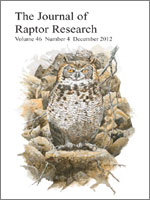Sexing of raptors is important for understanding their ecology and demography. Males and females of monomorphic species such as Red-shouldered Hawks (Buteo lineatus) may be distinguished using molecular and morphometric techniques. We collected blood samples and morphometric measurements from adult and nestling Red-shouldered Hawks in southern Ohio. We determined sex via amplification of the sex-linked chromo-helicase-DNA-binding gene and polymerase chain reaction. We used a suite of morphometric measurements to generate a recursive partitioning classification tree and in a linear discriminant analysis to determine the sex of adults and nestlings. For adults, the recursive partitioning tree utilized only mass to distinguish sexes, with an overall successful classification rate of 94%. For nestling hawks aged approximately 3 wk and older, mass and toepad (footpad) length were used to distinguish the sexes, with an overall successful classification rate of 91%. The ability to sex adults and nestlings in the field is valuable for studies of dispersal, survival, and behavior.
How to translate text using browser tools
1 December 2012
Sexing Adult and Nestling Red-Shouldered Hawks Using Morphometrics and Molecular Techniques
Cheryl R. Dykstra,
Herman L. Mays,
Jeffrey L. Hays,
Melinda M. Simon,
Ann R. Wegman

Journal of Raptor Research
Vol. 46 • No. 4
December 2012
Vol. 46 • No. 4
December 2012
Buteo lineatus
Morphometrics
nestling
raptor
Red-shouldered Hawk
sexing




